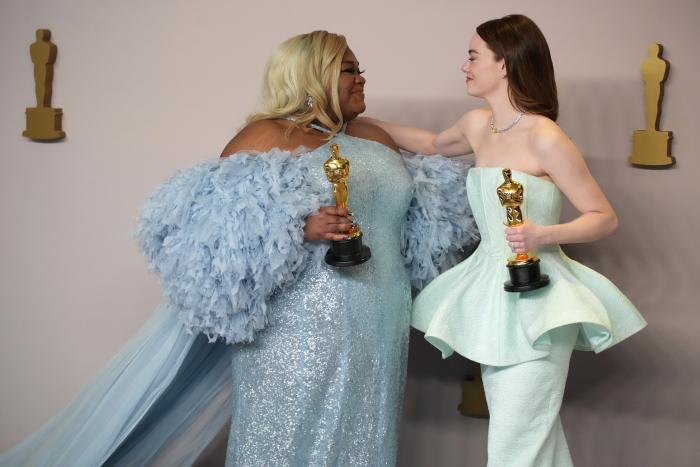

Review: Netflix's 'All the Bright Places' is a Problematic YA Weeper About a Manic (Depressive) Pixie Dream Boy
By Dustin Rowles | Film | March 7, 2020 |
By Dustin Rowles | Film | March 7, 2020 |

I read Jennifer Niven’s All the Bright Places a couple of years ago, and it was a bit like playing knock-off John Green bingo, right down to the manic-pixie dream girl, only here, it’s a manic-pixie dream boy and he is literally manic, as the character played by Justice Smith in the movie suffers from undiagnosed manic depression.
In both the novel and the movie — directed by Brett Haley and adapted by Niven and Liz Hannah — Theodore Finch’s manic depression is a feature, not a bug. It’s the sort of mood disorder that even those unaffected by it can empathize with because being a teenager in and of itself can feel like a mild form of manic depression, as your days are marked by euphoric highs and crushing lows.
Theodore Finch meets Violet Markey (Elle Fanning) during one of his manic states, as she is standing on a ledge and contemplating throwing herself off the same bridge that took her sister’s life in a tragic car accident. Violet is grieving, hard, and can’t bring herself to face the world. Theodore, who has absolutely no concerns about how others see him, basically infects Violet with his manic state. He brings her out of her funk through a school project upon which the two are paired, which asks them to wander around Indiana trying to find [quirky] little things to marvel upon. As Violet gradually wakes up — and as she and Theodore fall in love — the depression starts to kick in for Theodore and All the Bright Places takes a dark turn.
SPOILERS
At the risk of spoiling the movie, when I suggest it’s a knock-off John Green novel, I mean that in every sense, and for anyone who has read Green’s work, they’ll know exactly where Bright Places is heading. After Theodore Finch pulls Violet Markey out of her funk, his depression consumes him and he takes his own life. The target audience won’t care, because this particular strain of YA fiction is designed to make the reader/viewer weep, and weep hard. The movie is no exception, although — like the novel — it feels like its hewing close to a very particular formula inspired by both Nicholas Sparks and Green. While there is something cinematically romantic about a boy saving a girl from her own depression before taking his own life, it weirdly romanticizes suicide. The movie does have a hopeful ending — Violet learns to live again from someone who couldn’t — but the reality of that situation (girl loses her sister and her boyfriend) feels like it should be much darker, notwithstanding the touching a very sweet ending.
Justice Smith and Elle Fanning are terrific here, and the sheer power of their performances wakes up a lot of those YA tropes and gives them life. Smith is a quirky delight (until he’s not), and Fanning’s performance fills in several of the novel’s gaps with a lot of unspoken looks (her sh*tty ex-boyfriend, a bigger fixture in the novel, is reduced to a bit player in the movie).
Ultimately, All the Bright Places is exactly the movie it wants to be, and Brett Haley even manages to improve upon the book thanks to Smith and Fanning’s performances. It’s also the movie the target audience of teenagers wants to see, too, for the same reason teenagers wanted to watch Titanic in the late ’90s. That doesn’t make All the Bright Places a particularly good or an original movie, but it is an effective one, and while the film is dotted with red flags, it’s message is ultimately hopeful and the ending is more bittersweet than sad.
← Review: 'Run This Town' Focusing on Toronto Mayor Rob Ford's Downfall and Millennial Rage | How to Con Your Way Into Watching 'Ghost Ship' →
More Like This
Kyle Mooney's Horror-Comedy 'Y2K' Goes Too Hard on Kyle Mooney's Sense of Humor
'Imaginary' Almost Sucks
Box Office Report: Kung Fu Sandworms
The 2024 Oscars Were Great Right Up Until the End
Kristen Stewart's 'Love Lies Bleeding' Is Gonna Kick Your Ass And Make You Beg For More

What’s Old Is New Again: Old Hollywood Glamour Glitters at the 2024 Oscars
Al Pacino Presents Best Picture Oscar, Confuses Everyone
The Dangerous Lie Of 'TradWives'
A Legendary Horror Franchise Is Headed To Television
'The Mandalorian' Season 4 Is Probably Not Happening
Halle Bailey On Why She Chose To Keep Her Pregnancy Private
More Like This
Kyle Mooney's Horror-Comedy 'Y2K' Goes Too Hard on Kyle Mooney's Sense of Humor
'Imaginary' Almost Sucks
Box Office Report: Kung Fu Sandworms
The 2024 Oscars Were Great Right Up Until the End
Kristen Stewart's 'Love Lies Bleeding' Is Gonna Kick Your Ass And Make You Beg For More
Reviews